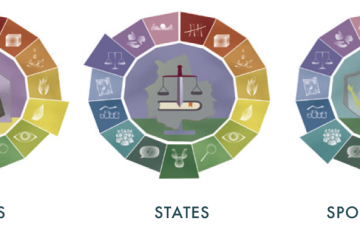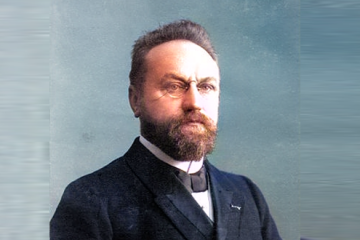
For the key to the icons, see this post on the multi-faceted meaning of life.
We’re beginning a series exploring the outlines of a Christian philosophy of the sciences. Not, I hasten to add, the Christian Philosophy of Science (as I know there’s a tendency for the tag “Christian” to evoke a sense of dogma!). Rather, I want to develop, aided by some guest bloggers and hopefully lots of comments and feedback from readers, a philosophical framework that could provide insights into what the sciences are, where they come from, and how we who are scientists can better go about our research. This series is also written with an eye to the next phase of Church Scientific.
Here I pick up from the Triune view of reality articulated by Jeremy Ive that I described last year, with input from Hendrik Hart’s “Understanding Our World” and the writings of Danie Strauss – although it is of course my own interpretation. Suppose we accept that the created world of our experience can be summarised as “things in relation over time”: how does scientific thinking apply?
Our starting point is that scientific thinking does not concern the uniqueness of things so much as classes, properties and behaviours that can be observed across multiple individuals or situations (universals). In French, scientific knowing is generally savoir, not connaître, distinguishing knowing about generalities (or that something pertains) from knowing particulars (like people, pets and places). In English the distinction is simply between intransitive vs. transitive verb forms, but the contrast remains. If I asked a zoologist friend, “How well do you know the alligator?”, I’d probably be asking about a particular alligator – unless I were using an old-fashioned idiom whereby species are taken as particulars (echoes of platonic realism… of which more later!). My zoologist friend’s professional interest would be in knowing about alligators in general: how they live. Or if we turn to the Bible for a moment, we may note that while most of the canonical material is about particular people, places and events (though not pets), the wisdom literature (e.g. Job, as magnificently explored by Tom McLeish) dwells extensively on generalities and might be seen as proto-scientific.
Many scientific fields have their origins in taxonomy: describing and classifying types of rocks and stars, species of organisms and diseases, personality types, family structures, etc. And thus the sciences proliferate concepts for types of particular things within a certain domain of interest. Developing sciences then take increasing interest in assessing temporal processes and interactive relationships: sedimentation, gravitation, reproduction, infection, development and geographical prevalence, for example – mostly using quantifiable variables. This is not metaphysics; rather these characteristically scientific interests concern conceptual abstraction. And modally-specific abstraction is perhaps the best single characteristic of “science”.
For all the celebration of science as a source of empirical knowledge, the empirical basis of abstraction is rather obscure. How do we come to see that this truffle and that truffle are both truffles, or to classify rocks – despite the fact that every single specimen is unique? Biologists may fall back on the biological species concept – but this is more of an ideal than a useful tool. If we seek refuge in nominalism and pretend we just made up the types for convenience, then the taxonomic elements of our sciences lose their appeal. But just as problematic is the abstraction of variables relevant to scientific processes and relationships – like mass, temperature, lifespan, fecundity and relatedness. How do scientists form these concepts and then discover theoretical relationships and formulate laws (often mathematically-beautiful ones) – merely from experiencing unique particulars? It would seem that humans actually engage with the law-side of creation.
This brings us to the diagram above. The particular things we directly experience (the white shapes) provide specific data for scientific reasoning, and subjects for scientific prediction, but the abstract kinds (white patches) and diverse relations (the rainbow aura) are perceived in a different way. Hart describes them as conditions and laws. As such, he says that they are real but do not exist; instead they “apply” or “hold”. Turning again to the Bible (especially the Psalms), this also seems to be the sense in which God’s word is real without being a creature. And here lies a key reason why this framework has a particular claim to being Christian.
For now, lots of intriguing questions could arise – e.g.:
- How do scientists actually relate data (particulars) to theory (abstract generalities)?
- Can a study of star constellations be called scientific? Or the discovery of a new planet, or of an underwater volcano?
- Does history count as a social science, or is it just about unique particulars?
- Can theology be the science of God?
- “Word of God” actually has several meanings – how do they relate to science?
These must be addressed in future posts in this series, which we plan to resume in the new year.
- Philosophy in full colour - October 21, 2025
- Flowers not flavours in AI: How large language models resonate with the beauty of creation - May 19, 2025
- Artificial thinking? - April 2, 2025


